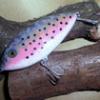Search the Community
Showing results for tags 'jointed lures'.
-
Hey guys i am new on here and new to lure building and painting. I painted my first bait yesterday and it was a jointed swim bait. i made a lure turner but i dont think it will work for this bait. I will include a picture of the lure. Does anyone know how i should topcoat this lure?
- 13 replies
-
Hi there , folks , Just got up from the workshop having shot some pictures for another thread , .....since I'm just busy painting and topcoating another bunch of lures , I've thought that following pictures might be of interest for one or another fellow carver in here . This is a simply made frame...





